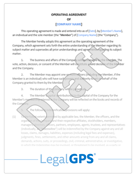Implementing Capital Interest and Profits Interest Plans for LLCs
Equity compensation is one of the ways companies provide additional incentives to employees. It can significantly enhance the company’s talent pool,...
5 min read
LegalGPS : Oct. 16, 2024
This blog is all about cap tables—what they are, why you need one, and how to create a cap table effectively for your startup. Let’s dive in!


Legal GPS Pro
Protect your business with our complete legal subscription service, designed by top startup attorneys.
A cap table, short for capitalization table, is a document that shows the ownership structure of a company by giving a snapshot of who owns what. It lists all of the company's securities, including shares, options, warrants, and who holds them. A very basic cap table for a startup with no outside investors or stock options may simply be a list of all the founders and the shares they hold.
A cap table is essential for several reasons. It helps you track ownership, prepare for funding rounds, and make informed decisions about company valuation and exit strategies. Let’s explore these in more detail:
A cap table clearly shows who owns what in the company. Without it, calculating ownership percentages becomes complex, especially when dealing with convertible notes, stock options, and new funding rounds.
Imagine you have a startup with two founders and 2,000 outstanding shares, with each founder holding 1,000 shares. Initially, each founder owns 50% of the company. If you issue stock options for 500 shares to an employee, you may still think you each own 50% because you still hold 1,000 shares each. However, if the employee exercises these options, your holding is diluted, and you will actually own only 40% each. A well-managed cap table will instantly show your diluted ownership, helping you keep track of your actual share in the company.
When seeking funding, one of the first documents investors will ask for is the cap table. It provides investors with a clear understanding of:
Pre-money valuations: The valuation of the company before new investment.
Impact on the option pool: How new investments affect the company's ability to attract talent.
Dilution considerations: How each new round of funding impacts existing shareholders.
Without a cap table, you may struggle to answer these questions, making a poor impression on potential investors.
If you receive an acquisition offer, the cap table helps you understand the distribution of proceeds among shareholders. By entering the proposed acquisition value into the cap table, you can see how much each stakeholder would receive upon exit. This helps you make informed decisions about accepting or negotiating an exit offer.
Equity Compensation Strategies for Startups
Let’s walk through how to create a simple cap table. To help, I’ve included a sample cap table template that highlights the essential information you need. By inputting key data into the highlighted fields, you can easily create and maintain your cap table.
To create a cap table, you need to understand the following key elements:
Common Shares: Typically issued to founders and employees. These are ordinary shares without special rights.
Preferred Shares: Usually issued to investors. Preferred shares often come with special rights, such as a priority claim to dividends or liquidation preferences.
"Preferred shareholders are entitled to receive dividends before common shareholders and have priority in the event of liquidation."
Total Number of Shares That Can Be Issued: Authorized shares are the maximum number of shares the company can issue, including those issued and those yet to be issued.
Impact on Franchise Tax: The number of authorized shares can impact franchise tax obligations. In some states, increasing authorized shares requires amending the articles of incorporation.
Check your state’s franchise tax regulations before setting the number of authorized shares. In some states, like Delaware, the franchise tax is based on the number of authorized shares.
Definition: Outstanding shares are those that have been issued and are currently held by founders, investors, or employees. They do not include shares that have been repurchased or canceled.
Importance: The number of outstanding shares is used to calculate ownership percentages and determine voting power.
Shares Reserved for Employees: An option pool is a set number of shares reserved for employees as incentives.
Effect on Dilution: Stock options, when exercised, lead to dilution of existing shareholders’ ownership.
Assume you have 200 outstanding shares, split evenly between two founders (100 shares each). If you create an option pool of 40 shares, and an employee exercises all their options, each founder’s ownership is diluted to 41.67% (from 50%).


Legal GPS Pro
Protect your business with our complete legal subscription service, designed by top startup attorneys.
Face Value of Shares: Par value is the nominal value of the shares, often set very low.
Founders’ Shares: Shares are typically issued to founders at par value to minimize the cost of acquisition.
In Delaware, companies can reduce franchise taxes by issuing shares at a par value instead of no-par. If you issue 1,000,000 shares at a par value of $0.0001, founders would only need to pay $1,000 to acquire them, which also minimizes franchise tax liability.
Pre-Money Valuation: The company’s valuation before an investment round.
Post-Money Valuation: The valuation after new investments have been added.
If an investor wants to buy 20% of the company for $200,000, the post-money valuation would be $1,000,000. The cap table will automatically calculate the number of shares to be issued based on the investment.
Calculation: Price per share is determined by dividing the post-money valuation by the total number of outstanding shares after the new investment.
Let your cap table automate these calculations to reduce the chance of manual errors and ensure accuracy during funding negotiations.
After each funding round, it is crucial to calculate post-money ownership to understand how much equity each stakeholder has after the issuance of new shares.
If you hold 3,000 shares out of 10,000 outstanding shares, you own 30%. After issuing 2,000 new shares to investors, your ownership percentage decreases to 25%.
Definition: The value each shareholder would receive if the company is acquired.
Scenario Planning: Use the cap table to simulate different exit scenarios by entering various valuation figures.
Use the exit valuation column in your cap table to model how different acquisition offers will affect payouts for each shareholder. This helps you prepare for negotiations and ensures fairness.
As your startup grows and takes on more investors, the cap table becomes more complex. Convertible notes, SAFEs, multiple funding rounds, and employee options can make managing a cap table challenging.
Solution: Use cap table management software to automate calculations and ensure accuracy.
Errors in a cap table can lead to incorrect valuations, ownership misunderstandings, and strained investor relationships.
Solution: Regularly review and update your cap table, especially after any new funding, option grants, or stock buybacks.
A cap table is a vital tool for managing your startup's ownership structure, preparing for funding, and planning for exit scenarios. By understanding key elements such as authorized shares, option pools, and valuations, you can maintain an accurate and effective cap table. This not only helps you stay organized but also ensures you’re ready for investors, funding rounds, and potential exits.
The biggest question now is, "Do I need a business lawyer?” For most businesses and in most cases, you don't need a lawyer to start your business. Instead, many business owners rely on Legal GPS Pro to help with legal issues.
Legal GPS Pro is your All-In-One Legal Toolkit for Businesses. Developed by top startup attorneys, Pro gives you access to 100+ expertly crafted templates including operating agreements, NDAs, and service agreements, and an interactive platform. All designed to protect your company and set it up for lasting success.

Legal GPS Pro
Protect your business with our complete legal subscription service, designed by top startup attorneys.

100+ legal templates, guides, and expert advice to protect your business.
Trusted by 1000+ businesses

Equity compensation is one of the ways companies provide additional incentives to employees. It can significantly enhance the company’s talent pool,...

This guide will walk you through two common ways to issue stock to your employees: direct stock grants and direct stock purchase plans. We’ll explore...

A Section 83(b) election can be a powerful tax strategy for individuals receiving equity compensation. In this guide, we'll explain what a Section...